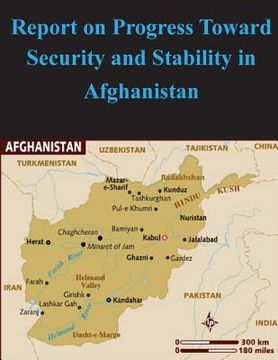Reseña del libro "Report on Progress Toward Security and Stability in Afghanistan (en Inglés)"
Afghan security forces are now successfully providing security for their own people, fighting their own battles, and holding the gains made by the International Security Assistance Force (ISAF) in the last decade. This is a fundamental shift in the course of the conflict. The Afghan National Security Forces (ANSF) have seen their capabilities expand rapidly since 2009, while insurgent territorial influence and kinetic capabilities have remained static. During the 2012 fighting season, ISAF led the fight against the insurgency, helping to put the Government of the Islamic Republic of Afghanistan (GIRoA) firmly in control of all of Afghanistan's major cities and 34 provincial capitals. During the 2013 fighting season, the ANSF led the fight, and have consolidated GIRoA's control of Afghanistan's urban areas. The fact that the ANSF - a force in its infancy five years ago - can now maintain the gains made by a coalition of 50 nations with the best trained and equipped forces in the world is a significant accomplishment. The ANSF now conduct 95 percent of conventional operations and 98 percent of special operations in Afghanistan. The only unilateral operations that ISAF continues to conduct are ISAF force protection, route clearance, and redeployment. A number of violence indicators are lower in this reporting period than they were during the corresponding period last year, including a six percent drop in enemy initiated attacks (EIAs), a 12 percent drop in security incidents, and a 22 percent drop in improvised explosive device (IED) events.2 However, this success did not come without costs, and the ANSF still face many challenges. ANSF casualties have increased by 79 percent this reporting period compared to the same period last year, while ISAF casualties have dropped by 59 percent. The insurgency has also consolidated gains in some of the rural areas in which it has traditionally held power. ISAF continues to provide the ANSF with significant advising and enabling support, such as airlift and close air support (CAS). This enabling support will decline through 2014, and will be difficult for the ANSF to fully replace. ANSF capabilities are not yet fully self-sustainable, and considerable effort will be required to make progress permanent. After 2014, ANSF sustainability will be at high risk without continued aid from the international community and continued Coalition force assistance including institutional advising. With assistance, however, the ANSF will remain on a path towards an enduring ability to overmatch the Taliban. However, military progress alone will not lead to success in Afghanistan. In addition to uncertainties about ANSF sustainability and challenges to security outside of urban areas, challenges with the economy and governance continue to foster uncertainty about long-term prospects for stability. This causes hedging behavior by actors in many sectors, which exacerbates existing instability. Afghanistan has made significant economic progress over the past decade, but it remains one of the poorest countries in the world, and will continue to depend heavily on international aid. The Afghan government is increasingly able to execute parts of its budget and to deliver very basic goods and services. However, the government must continue to work towards reducing corruption and effectively extend governance to many rural areas. Although problems remain, many of which are detailed in this report, ANSF progress means that the biggest uncertainties facing Afghanistan are no longer primarily military. Assessing whether the gains to date will be sustainable is now more dependent upon the size and structure of the post-2014 U.S. and North Atlantic Treaty Organization (NATO) presence, the Afghan election in 2014, the level of international support provided to Afghanistan after 2014, and whether Afghanistan can put in place the legal and other structures needed to attract investment and promote growth.

